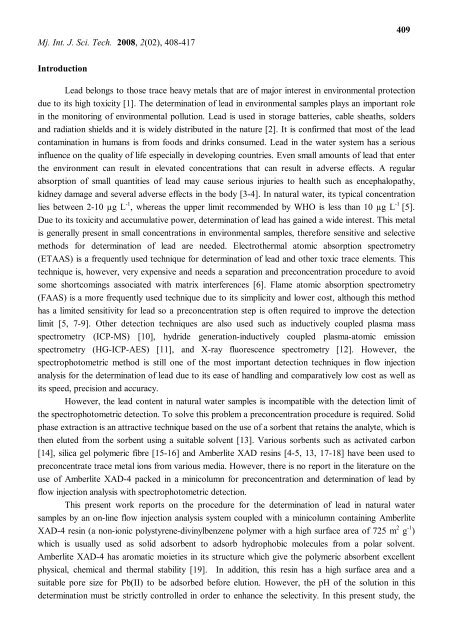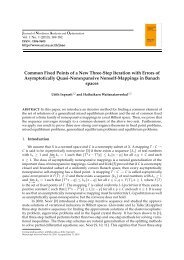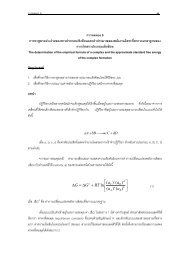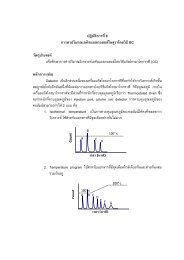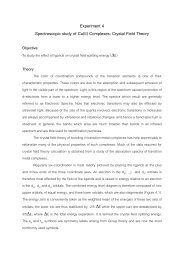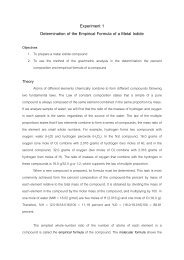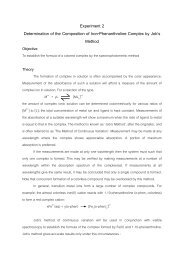A flow injection system for the spectrophotometric determination of ...
A flow injection system for the spectrophotometric determination of ...
A flow injection system for the spectrophotometric determination of ...
Create successful ePaper yourself
Turn your PDF publications into a flip-book with our unique Google optimized e-Paper software.
Mj. Int. J. Sci. Tech. 2008, 2(02), 408-417<br />
409<br />
Introduction<br />
Lead belongs to those trace heavy metals that are <strong>of</strong> major interest in environmental protection<br />
due to its high toxicity [1]. The <strong>determination</strong> <strong>of</strong> lead in environmental samples plays an important role<br />
in <strong>the</strong> monitoring <strong>of</strong> environmental pollution. Lead is used in storage batteries, cable sheaths, solders<br />
and radiation shields and it is widely distributed in <strong>the</strong> nature [2]. It is confirmed that most <strong>of</strong> <strong>the</strong> lead<br />
contamination in humans is from foods and drinks consumed. Lead in <strong>the</strong> water <strong>system</strong> has a serious<br />
influence on <strong>the</strong> quality <strong>of</strong> life especially in developing countries. Even small amounts <strong>of</strong> lead that enter<br />
<strong>the</strong> environment can result in elevated concentrations that can result in adverse effects. A regular<br />
absorption <strong>of</strong> small quantities <strong>of</strong> lead may cause serious injuries to health such as encephalopathy,<br />
kidney damage and several adverse effects in <strong>the</strong> body [3-4]. In natural water, its typical concentration<br />
lies between 2-10 µg L -1 , whereas <strong>the</strong> upper limit recommended by WHO is less than 10 µg L -1 [5].<br />
Due to its toxicity and accumulative power, <strong>determination</strong> <strong>of</strong> lead has gained a wide interest. This metal<br />
is generally present in small concentrations in environmental samples, <strong>the</strong>re<strong>for</strong>e sensitive and selective<br />
methods <strong>for</strong> <strong>determination</strong> <strong>of</strong> lead are needed. Electro<strong>the</strong>rmal atomic absorption spectrometry<br />
(ETAAS) is a frequently used technique <strong>for</strong> <strong>determination</strong> <strong>of</strong> lead and o<strong>the</strong>r toxic trace elements. This<br />
technique is, however, very expensive and needs a separation and preconcentration procedure to avoid<br />
some shortcomings associated with matrix interferences [6]. Flame atomic absorption spectrometry<br />
(FAAS) is a more frequently used technique due to its simplicity and lower cost, although this method<br />
has a limited sensitivity <strong>for</strong> lead so a preconcentration step is <strong>of</strong>ten required to improve <strong>the</strong> detection<br />
limit [5, 7-9]. O<strong>the</strong>r detection techniques are also used such as inductively coupled plasma mass<br />
spectrometry (ICP-MS) [10], hydride generation-inductively coupled plasma-atomic emission<br />
spectrometry (HG-ICP-AES) [11], and X-ray fluorescence spectrometry [12]. However, <strong>the</strong><br />
<strong>spectrophotometric</strong> method is still one <strong>of</strong> <strong>the</strong> most important detection techniques in <strong>flow</strong> <strong>injection</strong><br />
analysis <strong>for</strong> <strong>the</strong> <strong>determination</strong> <strong>of</strong> lead due to its ease <strong>of</strong> handling and comparatively low cost as well as<br />
its speed, precision and accuracy.<br />
However, <strong>the</strong> lead content in natural water samples is incompatible with <strong>the</strong> detection limit <strong>of</strong><br />
<strong>the</strong> <strong>spectrophotometric</strong> detection. To solve this problem a preconcentration procedure is required. Solid<br />
phase extraction is an attractive technique based on <strong>the</strong> use <strong>of</strong> a sorbent that retains <strong>the</strong> analyte, which is<br />
<strong>the</strong>n eluted from <strong>the</strong> sorbent using a suitable solvent [13]. Various sorbents such as activated carbon<br />
[14], silica gel polymeric fibre [15-16] and Amberlite XAD resins [4-5, 13, 17-18] have been used to<br />
preconcentrate trace metal ions from various media. However, <strong>the</strong>re is no report in <strong>the</strong> literature on <strong>the</strong><br />
use <strong>of</strong> Amberlite XAD-4 packed in a minicolumn <strong>for</strong> preconcentration and <strong>determination</strong> <strong>of</strong> lead by<br />
<strong>flow</strong> <strong>injection</strong> analysis with <strong>spectrophotometric</strong> detection.<br />
This present work reports on <strong>the</strong> procedure <strong>for</strong> <strong>the</strong> <strong>determination</strong> <strong>of</strong> lead in natural water<br />
samples by an on-line <strong>flow</strong> <strong>injection</strong> analysis <strong>system</strong> coupled with a minicolumn containing Amberlite<br />
XAD-4 resin (a non-ionic polystyrene-divinylbenzene polymer with a high surface area <strong>of</strong> 725 m 2 g -1 )<br />
which is usually used as solid adsorbent to adsorb hydrophobic molecules from a polar solvent.<br />
Amberlite XAD-4 has aromatic moieties in its structure which give <strong>the</strong> polymeric absorbent excellent<br />
physical, chemical and <strong>the</strong>rmal stability [19]. In addition, this resin has a high surface area and a<br />
suitable pore size <strong>for</strong> Pb(II) to be adsorbed be<strong>for</strong>e elution. However, <strong>the</strong> pH <strong>of</strong> <strong>the</strong> solution in this<br />
<strong>determination</strong> must be strictly controlled in order to enhance <strong>the</strong> selectivity. In this present study, <strong>the</strong>


